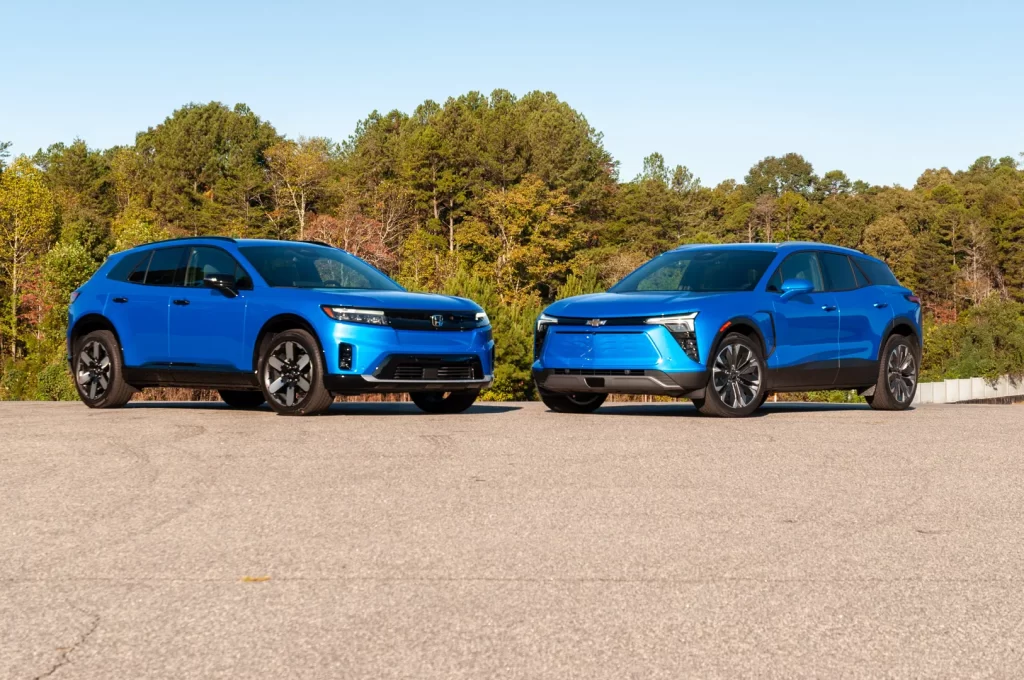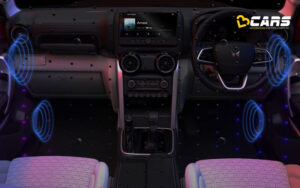
- The electric crossovers share the same battery and motors, but their personalities differ
- Honda Prologue handles a little softer and looks a bit calmer
- Blazer EV’s graphics and infotainment surpass the Honda
The Honda Prologue and Chevrolet Blazer EV are related electric crossover SUVs that don’t seem all that related. The Prologue is a tophat, in industry parlance, wearing a different style yet sharing GM’s battery propulsion system. They’re more like fraternal twins, looking and behaving differently yet of the same DNA.
Even though they both launched new for 2024, Chevy has begun expanding the trims and powertrain offerings on the 2025 Blazer EV. That’s a key difference in these fraternals: The 2025 Blazer EV already has more range and power, but it also has a much broader price range. The 2024 Honda Prologue is simpler, in configurations and style.
For the Honda faithful, the Prologue acts more as a stopgap for the EV curious as the brand develops its own electric vehicle platform set to launch in 2026.
Recent testing proved these twins are as alike as they are dissimilar. Here’s how.

Chevrolet Blazer EV vs. Honda Prologue

Chevrolet Blazer EV vs. Honda Prologue

Chevrolet Blazer EV vs. Honda Prologue
Honda Prologue vs. Chevy Blazer EV style
- Both models measure 192 inches long, similar to the gas Blazer or Jeep Grand Cherokee
- The Blazer EV appears sportier, or busier
- The Prologue has more chill
Is the Chevy Blazer EV a good looking car?
These tophats come from different milliners, for sure. Chevy works twice as hard to make the Blazer EV stand out from its gas model of the same name as well as from its Prologue twin-under-the-skin. Up front, the Blazer EV dons a batwing fascia with a black bar stamped with a bow tie. It flexes out into more complex running lights that hide the headlights, then the black fascia drops down to a stack of light cubes. The grille cover is stamped with waves so it appears more prominent than the Prologue’s. The Blazer’s busyness continues on the side with a fender indent and a black gloss C-pillar that marks the biggest departure. The floating roof look is played out, and looks like a long black bandit mask wrapping around from the rear doors to the tailgate.
The Prologue follows the new Pilot and Passport with a solid body color panel that breaks up some of the wraparound black. The Blazer cloaks its back with a two-fanged integrated roof spoiler whereas the Honda stretches flat across. The Blazer’s taillights have a similar take on the front, wrapping around like a boomerang tripod.
The busyness continues inside, with massive tubular side vents in plastic nacelles that evoke a bank teller canister. Three circular vents in the center of the dash one-up the Camaro—remember the Camaro? Chevy surpasses the Prologue with a 17.7-inch touchscreen integrated alongside an 11.0-inch gauge cluster that’s cleaner, neater, and more integrated than the aftermarket slapped-on look of the Prologue’s staggered screens.
Is the Honda Prologue a good looking car?
In general, the Prologue is cleaner, simpler, prettier, and more straightforward than the Blazer EV, whose edginess works best on RS grades. The Prologue’s sedate face stretches long and thin, with a band for the headlights and slim running lights as eyebrows. Pert vertical intakes flank a more pronounced lower grille than the Blazer EV. The rear end matches the front with a black bar connecting wrap-around taillights. The badge above the bar relieves copy editors and grammarians everywhere, with a capital H and lowercase on the rest. Thank you, Honda.
The long and thin design stretches out inside as well, but the interior feels more GM than Honda. GM’s graphics are light years ahead of Honda, so it benefits the Prologue here. Honda has the same gauge cluster but its 11.3-inch touchscreen sticks up from the dash like an add-on.
They both have massive flat spans between the front dash and the windshield cowl. It looks like a huge griddle. One other misstep: They both have the drive mode, auto hold, and lane keep buttons hidden inconveniently in a panel by the left knee that’s hard to see while driving.
Advantage: Honda Prologue.

Chevrolet Blazer EV vs. Honda Prologue

Chevrolet Blazer EV vs. Honda Prologue
Honda Prologue vs. Chevy Blazer EV performance
- Driving impressions below are limited to dual-motor all-wheel-drive models
- The Blazer EV can be had in front-wheel-, all-wheel-, or rear-wheel-drive configurations
- Both AWD models generate 288 hp and 333 lb-ft of torque
Both models share a dual-motor AWD system with a permanent magnet up front and a smaller induction motor in the rear. Together, the motors generate 288 hp and 333 lb-ft in both models. An 85-kwh battery pack provides the juice. The Blazer EV can be configured as a more performance-minded EV with a 102-kwh battery pack and a larger permanent magnet rear motor generating 340 hp and 325 lb-ft.
There are also front-wheel-drive models with just the permanent magnet motor up front.
Our head-to-head testing was limited to the AWD models, and it reveals how slight mechanical differences can add up to a notable presence behind the wheel.
How the Blazer EV and Honda Prologue differ behind the wheel
Both models can hit 60 mph in the mid-six-second range. There’s plenty of lurch off the line, and enough available torque at any time to make even uphill passing moves spirited.
The differences come in the handling and steering.
The Blazer has more lift at launch and the steering is tuned tighter so there’s more resistance and a heavier feel. But the five-link independent suspension feels flabbier. Going over rolling hills at speed tickles the tummy, then in the sharper esses it leans more.
The Prologue has greater stability and overall balance, and lacks the wobbles of the Blazer. Part of this has to do with different springs and dampers used by Honda to make it feel more like a Honda. It feels less high-strung, with a smaller delta between rebound and compression travel. That makes it a little more absorbent while cruising.
On the other hand, in the hands, the Prologue’s steering feels more numb, and the road tracing feels more vague. It’s tuned more for ease and comfort, and that’s magnified by the standard acoustic glass that extends to the side windows on the top Elite trim. It’s a quieter, calmer ride.
One other note: the Prologue’s front seats have a stitched seam that runs under your knees, so it feels like a shorter seat bottom. The Blazer’s front seat envelops the thighs and sides more.
Advantage: Honda Prologue.

2025 Chevrolet Blazer EV

2025 Chevrolet Blazer EV

2025 Chevrolet Blazer EV

2025 Chevrolet Blazer EV
Honda Prologue vs. Chevy Blazer EV size and cargo capacity
- Both models have long wheelbases for generous passenger and cargo space
- Base Prologue EX has 25.2 cargo feet behind the rear seats whereas other trims have 23.7 cubes
- Blazer EV is marginally roomier with 25.8 cubic feet but rear headroom can be pinched by the panoramic sunroof
- Neither model has a front trunk
The interior space is where these twins are most similar, with large door cut outs for easy entry and exit as well as a long wheelbase of 121.8 inches and open cabin that’s roomier than most midsize SUVs, including the Honda Passport (110.9 inches) and Chevy Blazer (112.7). An open floor plan allows for plenty of room for heads and shoulders, but the panoramic sunroof on mid-grade and top models cuts rear headroom by 1.5 inches, presenting a problem for taller passengers. Another nit about the rear seats is where the back meets the seat bottom. There’s a bump housing the child safety LATCH points that sticks right under the lumbar area, so you need to slump a bit to get comfortable.
Advantage: It’s a draw.

2024 Honda Prologue

2024 Honda Prologue

2024 Honda Prologue

2024 Honda Prologue
Honda Prologue vs. Chevy Blazer EV price and trims
- Prologue single motor costs $49,000; Touring $53,000; dual-motor AWD adds $3,000; Elite with AWD cost nearly $60,000
- Chevy Blazer EV LT single-motor FWD costs $46,000; dual-motor AWD adds $3,000; RS AWD costs $54,300; RS RWD $57,000
- All models qualify for the $7,500 federal EV tax credit deducted at the dealer
- Prices include $1,395 destination fee for both models
How much is a Honda Prologue? Which Prologue should I buy?
Prices and features on the Honda Prologue are more straightforward, and with fewer drivetrain configurations. The base Prologue EX front-wheel-drive model has an 11.0-inch configurable gauge-cluster and a 11.3-inch touchscreen that’s not as well integrated as Chevy’s and clearly comes from GM. Unlike the Chevy, however, wireless Apple CarPlay and Android Auto compatibility are included, as is a wireless phone charger.
In that sense, it’s not only simpler but more convenient than the Blazer EV. It has heated front seats and a power driver seat, but lacks some of the Blazer EV LT’s features. We’d stick with the base EX here, as the $53,000 Touring’s panoramic sunroof and Bose audio don’t add up. The $60,000 Prologue Elite would make our heads turn to something upstream, such as an Audi Q6 or Genesis GV60.
How much is a Chevy Blazer EV? Which Blazer EV should I buy?
The Chevy Blazer EV has more choice—and confusion—in its lineup. The LT is the base model but as of this posting, it can only be had with AWD for $49,000. Chevy says the single-motor front-wheel-drive LT will arrive “soon.” The LT is enough Blazer EV for us, as the options packages muddle the content for the price of the RS. Additionally, Chevy charges extra for a charge cord and denies Apple CarPlay.
The LT has a 17.7-inch touchscreen with Google Built-in (but no Android Auto or Apple CarPlay), an 11.0-inch digital instrument cluster, synthetic leather upholstery, adaptive cruise control, and 19-inch alloy wheels. The $54,300 RS AWD blacks out some trim pieces and rolls on 21-inch black wheels that may look cool but eat into efficiency. It adds a wireless smartphone charger, heated and cooled front seats that are power adjustable, a heated steering wheel, power tailgate, and opens up more options. The performance-oriented RS with rear-wheel drive and the larger 102-kwh battery tops the lineup at $57,000.
Advantage: Chevy Blazer EV, if you can do without CarPlay.

2025 Chevrolet Blazer EV
Chevy Blazer EV vs. Honda Prologue range and charge times
- Prologue EX FWD has a 296-mile range, and goes 2.9 miles per kwh; the AWD Touring is 281 miles, 2.8 mi/kwh; the Elite is 273 miles, 2.7 mi/kwh
- Blazer EV AWD has a 283-mile range, 2.8 mi/kwh; RS RWD has 324-mile range, 2.7 mi/kwh
- All but the Blazer EV RS RWD has a 85-kwh battery pack
They both roll on 19-inch wheels, have traditional door handles, and share similar range and efficiency ratings. The RS RWD uses a larger 102-kwh battery pack, which is why it is the range king.
In our back-to-back testing on identical road loops, going the same speeds in a lead-follow test, the Prologue was more efficient. It had a 1.9 miles per kwh rating versus 1.7 mi/kwh for the Blazer EV.
How fast do the Honda Prologue and Chevy Blazer EV charge?
Both models DC fast-charge at a peak rate of 150 kw. Honda claims up to 65 miles in 10 minutes, or 35 minutes to get the battery from 20% to 80%. Chevy claims 70 miles in 10 minutes and an 80% state of charge in 30 minutes. In the real world, they’re similar.
At home on a Level 2 240-volt AC connection that accepts up to 11.5 kw, both models should charge to full overnight in less than eight hours.
The Blazer EV RS RWD can charge at up to 190 kw, and that adds 78 miles in 10 minutes.
Note that Chevy charges extra for a charge cord whereas Honda makes it standard in the Prologue.
Advantage: It’s a draw.

2024 Honda Prologue
Chevy Blazer EV vs. Honda Prologue: Which one is better?
It may not be much of a surprise that the 2025 Chevy Blazer EV and the 2024 Honda Prologue add up to an even 7.4 out of 10 for their TCC Ratings. Beyond the ratings, these twins have their differences, settled on how you perceive the styling and if you prefer the edgier, busier Blazer EV or the chiller Prologue. Our editorial team leans toward the latter for its calmer style and smoother ride.



